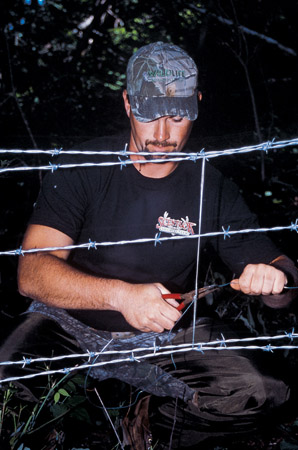 One proven method of funneling deer is altering fences. Deer often travel significant distances to cross at the easiest point in a fence. For hunters, this is an advantage.
One proven method of funneling deer is altering fences. Deer often travel significant distances to cross at the easiest point in a fence. For hunters, this is an advantage.
My first attempt at creating a fence crossing occurred many years ago on my uncle’s dairy farm. I had spent a summer’s day walking a barbed wire fence line that cut through the middle of his woods. About every 100 yards, I would intercept a trail that crossed the fence. The problem was that no trail seemed better than any other.
Luckily, I took care of this with a little work. After selecting the fence crossing that was best for hunting, I invested a day in discouraging deer to use any other. To do that, I clogged the other spots where deer crawled under and fixed up the places where the top wire strand was broken or drooped.
Finally, I made the crossing by my stand even better. Wrapping a strand of wire around the fence and cinching it tight created both a low spot over which deer could jump and an easier path to crawl under. Shoveling out some dirt underneath the fence was the icing on the cake. With that, I had the best fence crossing point.
Opening day of bow season found me perched in the tree that overlooked my new fence crossing. Because of the deer sign I saw during the times I inspected and maintained my fence blockades, I was brimming with confidence. So much so, that I passed shots on the first four deer that came through. That may not sound like much, but in those days shot opportunities were rare, and they were the first deer I had ever taken a pass on. By the fifth, a large doe, I couldn’t resist any longer and shot as she paused before crossing. This demonstrates another advantage of these fence-crossing funnels: Deer often pause, posing for the shot, before attempting to cross. The result is often a perfect shot opportunity.
As productive as that technique is, we can take it a step further to promote the use of our crossing. Adding a strand to the top and bottom of the fence goes a long way towards discouraging crossings at other locations. It is best to use barbed wire when adding an extra strand; however, bailing twine will also work.
Another way to use fencing is to erect it to funnel deer activity. A mere 20 to 50 yards is all I generally use. Both snow fence and chicken wire work very nicely for this. Although I use this technique very sparingly, it can be extremely effective.
For example, I have a stand that is 75 yards south of a river. The most commonly used trails are within 30 yards to the south of the stand. However, every now and then a buck skirts the river without offering me a shot opportunity. Still, if I relocated closer to the river, I would miss more opportunities.
Then, one day it hit me. Just make it so that the deer couldn’t skirt me along the riverbank. Although I could have piled brush, placing 50 yards of chicken wire from the river toward my stand was much easier. Doing so has resulted in harvesting several three-year-old bucks that would have otherwise escaped unscathed.






